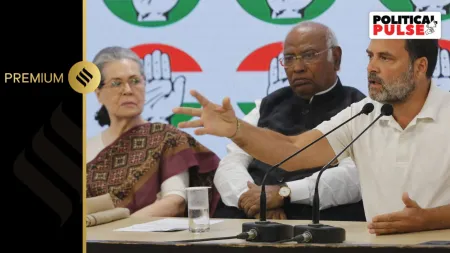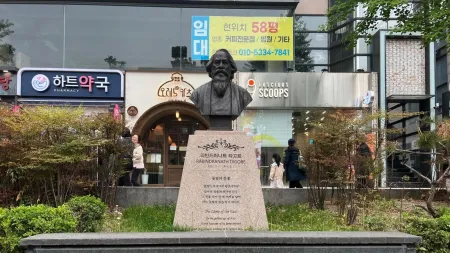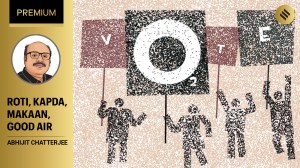- India
- International
Ashutosh Varshney writes: What government-Adani relationship says about Indian capitalism
Unlike 'national champions' of South Korea, Adani group is in sectors which are not internationally competitive. There is little it can sell on the world market without the help of New Delhi
 Compared to South Korea, the Adani-government nexus is a very different kind of national champions' strategy.
Compared to South Korea, the Adani-government nexus is a very different kind of national champions' strategy. For perspective, the Adani saga requires a comparative and historical exploration. The key question is: What do we know about the government-business nexus in the evolution of capitalism? How is contemporary India similar or different?
When one thinks of advanced capitalism, it is believed that companies rise or fall based on product innovation and/or cost reduction. Have firms come up with a product that excites the imagination of millions of consumers – an Apple computer or an iPhone? Or have they caught the fancy of thousands of other firms via a new production technique or better machines (for example, a newly robotised production system creating transport equipment or industrial machinery)?
This may be called a typical textbook description, not a realistic picture of advanced capitalism. And that would be partly true. Advanced capitalism is not wholly driven by what Adam Smith called the invisible hand of the market. Business-government links do exist – famously, in defence industries — but also in areas covered by industrial policy. Last year, Joe Biden announced subsidies for the advanced semiconductor industry of the US and also for firms that produce environmentally-superior products such as electric cars. But government-business collusion, while it may exist in advanced capitalism, is not extensive or rampant. It often gets caught, and is punished. Moreover, policies tend to be industry-specific, not firm- or family-specific.
In contrast, early capitalism is a very different beast. Corruption has historically accompanied the rise of capitalism. Consider the period 1865-1900, when a primarily rural America went through its first big capitalist transformation. Through his literary eye and intellectual foresight, Mark Twain first detected the essence of the new economic turn. In 1873, he called it the “Gilded Age”. Cutting all sorts of deals with governments at various levels, America’s first billionaires — the Carnegies, the Rockefellers, the Vanderbilts, the Morgans — emerged on the scene. For laying his railways lines, declared railroad baron Jay Gould, “I wanted the legislatures of four states… so I made them with my own money”. The so-called robber barons simply “bought” governments and legislatures.
A cleaning up began under President Theodore Roosevelt (1901-09) and the results, in part, began to show. In 1860, compared to Western Europe, America was a laggard. By 1910, the US had become the richest country in the world, leaving behind Britain, an industrial leader for over a century.

Meaning a simultaneous presence of rot and dynamism, Twain’s “Gilded Age” has stuck as a term and has been used ever since. The most recent version is China’s Gilded Age (2021), a widely read book by Yuen Yuen Ang (University of Michigan, Ann Abor). She distinguishes four kinds of corruption: (1) “Petty theft” (extortion by street-level bureaucrats and misuse of public funds); (2) “Grand theft” (embezzlement of huge amounts of public money by political elites); (3) “Speed money” (petty bribes to get around bureaucratic obstacles); (4) “Access money” (benefits and compensation provided by businessmen to politicians and bureaucrats for contracts and projects that raise overall investment rate and thereby economic growth).
She argues that the first three forms of corruption hurt national economic growth, but China has increasingly moved towards the fourth type of corruption, which is investment-enhancing and therefore also growth-promoting, while in the process benefitting Communist Party elites at all levels of the polity. During 1995-2015, China’s investment/GDP ratio never dropped below 40 per cent, and its annual growth rate was rarely below 9 per cent.
It may be tempting to argue that the Adani-BJP government links are about the fourth category. Whatever he may have especially contributed to the BJP, Adani investments are after all heavily in infrastructure, energy, grain storage, cement. These could, in principle, be called growth-enhancing.
But that would be too simplistic a comparison. The most interesting parallel for Modi’s India is not China, but South Korea, one of the first four “Asian tigers” after the Second World War. In the early 1960s, South Korea’s per capita income was roughly the same as India’s. In December 2021, according to the World Bank, South Korea’s per capita income was $34,758, whereas India’s was just $2,100.
(Incidentally, in terms of per capita income, China, at $10,262, is still not a high-income country.)
The comparison with South Korea is more appropriate, for its gilded age, starting around the mid-1960s, had a distinctive feature. Unlike China, it was a gilded age with “national champions”, such as Samsung, Hyundai, LG, Hanjin. These were the so-called “chaebols”, essentially family-dominated muti-sector business groups. They flourished under government patronage, as did the South Korean economy. But corruption accompanied their rise. In Crony Capitalism (2002), David Kang (University of Southern California), a leading scholar of South Korean political economy, writes: “Scandals are a recurrent theme of Korean political history, and the exchange of money for political influence has been… an open secret… Among those who have served time in jail or have been exiled are former presidents… members of presidential staff, …military officers, politicians, bureaucrats, bankers, businessmen and tax collectors… Growth was so spectacular that the reality of corruption was concealed…”
The greatest difference between Korean chaebols and the Adani group is that the former were heavily international trade-oriented. Government patronage notwithstanding, Samsung, Hyundai, LG have all been in tradable sectors. They have produced cell phones, computers, electronics, semiconductors and autos, and competed with the world producers. International competitiveness thus has provided a disciplinary check on their businesses, generating huge efficiencies.
The Adani group is mostly in non-tradable sectors. Seaports, airports, grain warehouses, electricity generation are not internationally traded. They are both government-patronised and domestically focused. The efficiency gains that come from international trade are not there. The Adani group is not a Samsung — there is very little it can sell on the world market without the help of Delhi. Nor does it compare with the international competitiveness of India’s information technology sector. Compared to South Korea, the Adani-government nexus is a very different kind of national champions’ strategy. Its implications for the larger economy simply can’t be as beneficial without international competitiveness.
Indeed, it is not through international trade, but through international financial instruments that the first disciplinary check on the Adani group has finally been exercised. International capital markets are punishing the group’s business practices. The story is not over yet. Much is still to come.
The writer is Sol Goldman professor of international studies and the social sciences at Brown University
EXPRESS OPINION
More Explained
May 09: Latest News
- 01
- 02
- 03
- 04
- 05









































